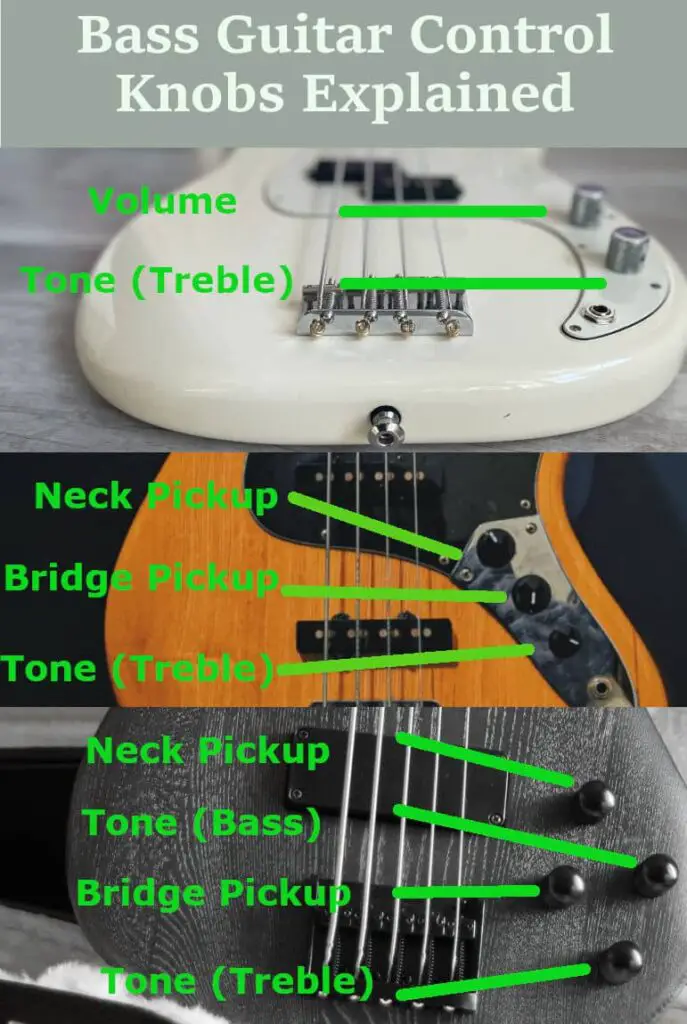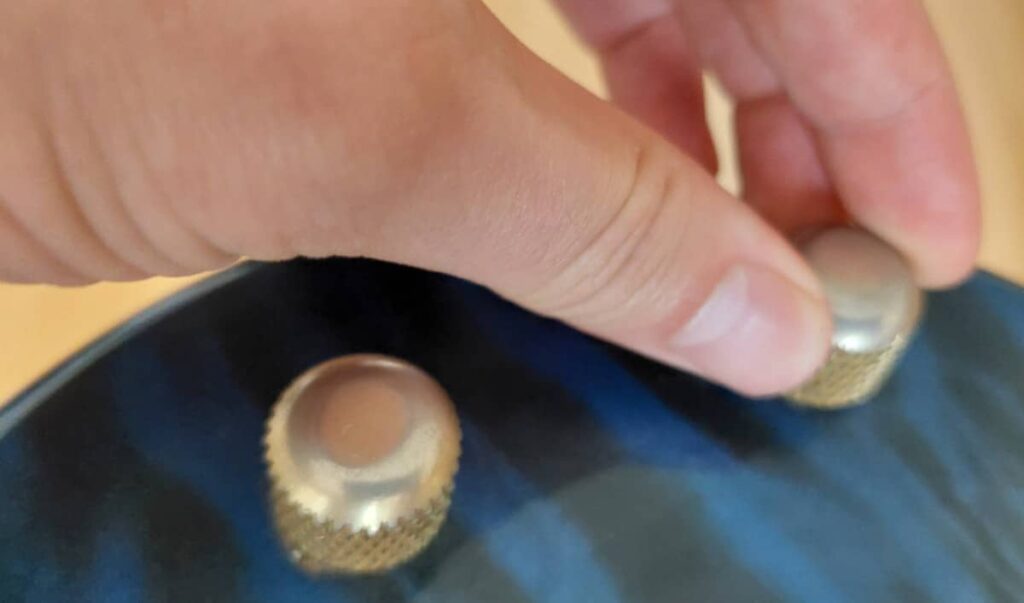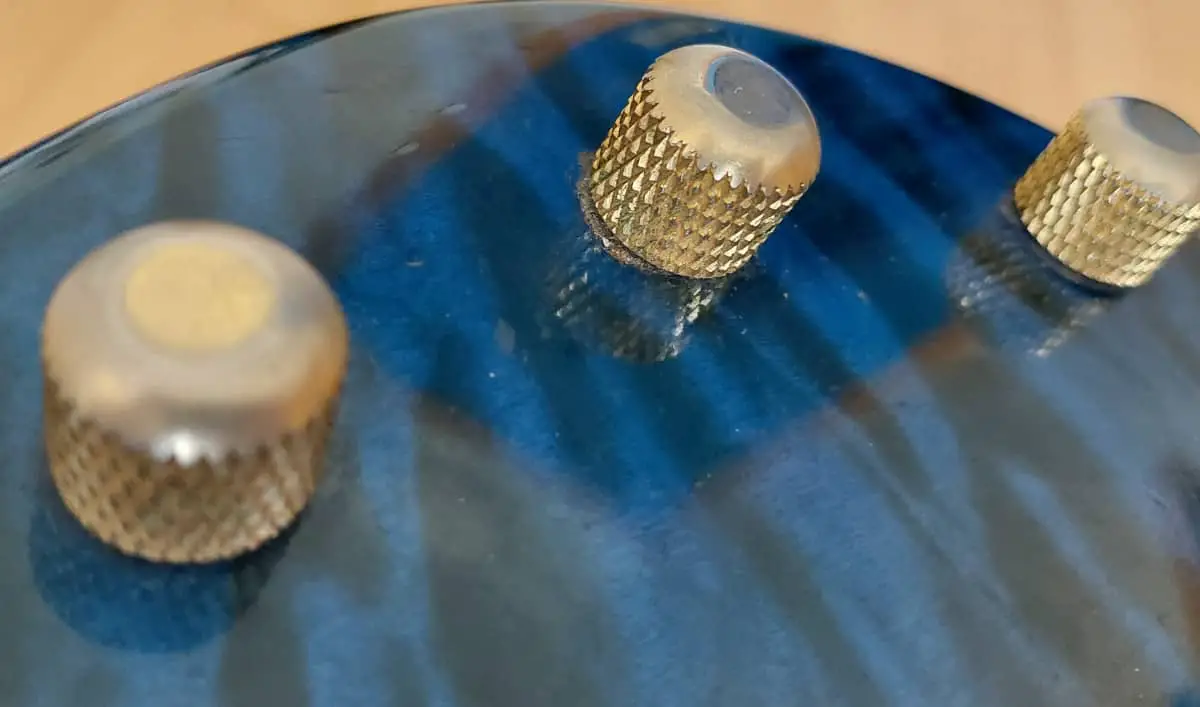For us bassists, tone is everything. The first step to getting a great tone is to utilize the built-in options on our basses. This is mainly done using the knobs on our instrument, but what do the knobs on an electric bass do?
The knobs on an electric bass are used to adjust the volume of the pickups and to equalize the tone. Turning up, muting, or blending the pickup volume knobs will affect tone and volume. Bass guitars also have at least one tone knob for treble, with some basses having additional knobs for low and mid-range frequencies.
Active and passive basses have their knobs set up differently. You also need to be mindful of what part of your tone you should set with your knobs, and what should be set directly on the amp.
Thus, I have written this article to help you identify what the knobs on your bass guitar do for all types of basses. You will also learn some useful tips on how to use your knobs and how to avoid some common mistakes.
What are the knobs on a bass called?
There are only two types of knobs on a bass: volume and tone. Depending on your bass, the volume knobs can be divided into Master volume, pickup blend, and individual pickup volume. Tone knobs are used for low-end (bass), mid-range, and high-end (treble).
Most basses have 2-5 knobs, and they are on of the most important parts of the bass.
Which knobs your bass has, largely depends on whether it’s an active or passive bass and the manufacturer of it. Here`s a list of the types of knobs basses have:
- Master volume – The master volume knob sets the overall volume output of your bass.
- Blend knob / Blend switch – If you have a master volume knob, you might also have a blend knob that determines which pickup the bass uses. On some basses, it looks like a switch rather than a knob. Turned all the way right it will solo one pickup, and all the way left it will solo the other. In the middle, it enables both. Turning the knob clockwise will enable the pickup closest to the fretboard.
- Pickup volume – Instead of a master volume and blend knob, your bass might have individual volume knobs for each pickup. You can use the pickup volume knobs to enable one pickup, multiple pickups, or partly turn up one pickup while turning another all the way up. Individual pickup knobs give you the same flexibility as a master volume and blend knob.
- Treble (High-end) – If your bass only has 1 tone knob, it is in all likelihood used to adjust the treble.
- Bass (low-end) – If your bass 2 tone knobs, you are generally looking at a treble knob and a bass knob. Turning low frequencies up will not turn down high frequencies, or vice versa, and the knobs thus serve different functions.
- Mid-range – Lastly, some active basses will also have a mid-range knob. This knob is used to further EQ and customize your tone, by giving you control of the frequencies between the low and high range.
While the function of bass knobs differ, here is an infographic of what you can generally expect when there are 2, 3, or 4 knobs on a bass guitar:

How do you use a bass tone knob?
When A bass only has one tone knob, it generally controls treble. Turning it up will result in a more airy, twangy, and clicky noise that will cut better through a mix. Turning it down results in a softer, darker tone with more depth that is less intrusive to a band’s overall sound.
The treble knob not only has a massive impact on the tone of a bass but also the sound of a band as a whole.
Turning the treble knob up will make the bass more audible in a band setting. Higher frequencies will have an easier time cutting through other instruments and sound sharper. It will also pick up some of the sounds of your picking hand, which will give your playing a lot more character.
A high treble will make your playing more pronounced. It can also interfere with what the other instruments are doing, and result in unwanted perceived loudness. It will not actually be louder, but it will sound that way because your bass is cutting through the mix.
Turning the treble down generally makes it hard to hear the bass, but makes it easier to feel it. This results in a softer tone with less perceived loudness to it. It makes it easier to fill in the low end without being intrusive to other instruments and gives the song a smooth character.
As for basses with 2 or 3 tone knobs, you have a lot more control over your tone. Turning up the bass knob creates a full and boomy sound. Turning it up is helpful if you are struggling to fill in the low-end properly, but too much becomes noisy and overwhelming.
The mid-range knob gives a lot of character to your playing and the accenting of your picking hand becomes a lot more noticeable.

The knobs on popular bass guitars
Here`s what the knobs do on some common bass guitars. This serves to give you an idea of common knob layouts, and potentially help you identify the knobs on your bass. The knobs are listed from the neck down, meaning that the first one is closest to the fretboard, and the last one is closest to the bridge.
What are the knobs on a fender jazz bass
- Neck pickup volume – Darker tone
- Bridge pickup volume – Brighter tone
- Tone – Treble control
Fender precision bass knobs function
- Master Volume knob – The P bass only has a 1 split coil pickup which is controlled by this knob
- Tone – Treble control
Squier P bass knobs function
- Master volume knob – Controls the volume of the split coil pickup.
- Tone – Treble control
Squier PJ bass knobs function
- Volume – Neck pickup
- Volume – Bridge pickup
- Tone – Treble control
Rickenbacker 4003/4001 knobs function
- Switch – Switches between pickups, set the switch to the middle to use both
- Volume – Neck pickup
- Tone – Bass control
- Volum – Bridge pickup
- Tone – Treble control
Ibanez GSR200 bass knob functions
- Tone: “Phat 2 Tone EQ”, mainly impacts bass frequencies
- Volume: Neck Pickup
- Tone: Treble Control
- Volume: Bridge Pickup
Conclusion
While some basses have 2 knobs, and others have 5, they always have the same basic functions: volume and tone control.
For basses with multiple pickups, you can control the volume of both or blend their sound. Adjusting your pickup volume also has an impact on your tone. While pickups vary from bass to bass, the neck pickup generally has a darker tone than the bridge pickup.
A singular tone knob will generally control the treble. A higher treble makes the tone of the bass brighter and more pronounced in a mix. Lowering it makes it blend better into a mix and produces a darker tone.
2 tone knobs typically mean one controls bass and one controls treble. If you have 3, you also have control of your mid-range frequencies.
More bass results in a fuller and boomier sound, which can add heaviness and power to a song when used in the right amounts. However, too much can result in an overwhelming tone. Boosting mid-range can make the bass easier to hear and make your plucking style more pronounced in a mix.
Lastly, be willing to experiment with your tone, and always use adjust your knobs to fit the mood of the song.

